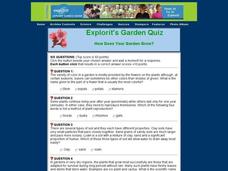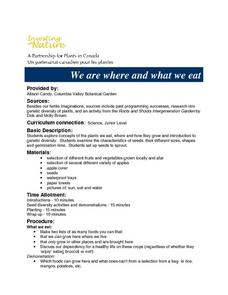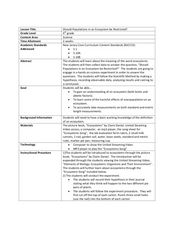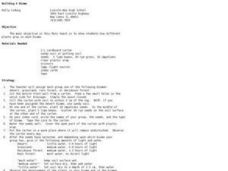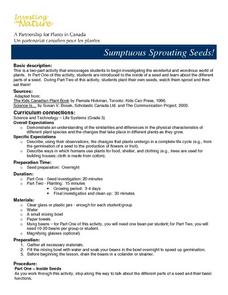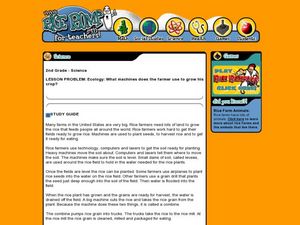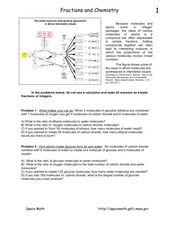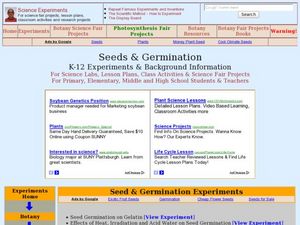Curated OER
Making Community Measurements: Which Plant Part?
Students identify a plant in a given community and make a variety of measurements. They determine how a plant meets its basic needs. In addition to identifying plant parts, they observe seasonal change and compare plants within a community.
Curated OER
Shelter
Students study shelter and how plants, animals, and people must have shelter to survive. In this shelter lesson, students read paragraphs about various shelters and their necessity with plants, animals, and people.
Curated OER
Explorit's Garden Quiz: How Does Your Garden Grow?
In this plants worksheet, students complete a 6 question multiple choice quiz about gardening, plants and agriculture. This is an online interactive worksheet.
Curated OER
Plant Growth and Environment
Third graders bring to school various green plants and categorize them into plant leaves, stems, roots, and fruits. They answer the question, "How can you show there is starch in a plant?" and perform the iodine test and describe the...
Curated OER
We are where and what we eat
Students explore concepts of plants they eat, where and how they grow and are introduced to genetic diversity. They examine seed characteristics, look at their different sizes, shapes and germination time. They also set up seeds to...
Curated OER
Spring Fever
Students grow plants from seeds that can later be placed in outdoor settings. They care for the seeds while they germinate and begin to leaf out.
Curated OER
Pollen Tracks
Learners participate in an artificial dig investigating imitiation rock samples that contain "pollen" from ancient plants. Students determine which plants the pollen samples came from.
Curated OER
Dune Plan Adaptations
Students tour Coal Oil Point Reserve. They locate the species of plants that are on the handouts ,and describe the different adaptations used by plants in their specific area of the dunes.
Curated OER
Seeds and Similarities
Students use the scientific inquiry method to identify the changes in a plant's life cycle. In groups, they plant different types of plants and use a chart to compare and contrast their growth rates. They share their conclusions with...
Curated OER
Should Populations in an Ecosystem be Restricted?
Fourth graders experiment to determine how overpopulation effects ecosystems specifically plants. In this ecosystem lesson, 4th graders conduct an ecosystems experiment after listening to Claire Daniel's, Ecosystems. They watch a video,...
Curated OER
Leaves and Photosynthesis
For this science worksheet, students read detailed information about green plants and the photosynthesis process. In this fill in the blank and true and false worksheet, students answer twelve questions.
Curated OER
It's All About the Roots
Students investigate the process of hydroponic agriculture. They grow beans in different hydroponic solutions, compare results and graph their observations.
Curated OER
Building a Biome
Students investigate how plants grow in different biomes. In this biomes lesson plan, students plant sees of impatiens, lima beans and rye seeds in egg cartons. When the plants begin to grow they simulate the assigned biome conditions...
Curated OER
Photosynthesis: Using the Sun to Make Food
In this photosynthesis worksheet, students learn how plants use the sun to convert energy into food. They then answer 10 questions using the information they just read. The answers are on the last page.
Curated OER
Sumptuous Sprouting Seeds!
Third graders investigate the wonderful and wondrous world of plants. They examine the inside of a seed, explore the different parts of a seed, plant their own seeds, watch them sprout and then eat them! They describe, using their...
Curated OER
Machines Rice Farmers Use
Second graders investigate rice farming. In this farming equipment lesson, 2nd graders discover what type of equipment is needed to get rice farms ready to plant. Students gain knowledge about what a combine does and how it is important...
Curated OER
Understanding How Potatoes Grow
Second graders make a KWL chart and brainstorm what they need for the project of growing potatoes. They choose one potato and plant it in water or peat moss cups and choose a location in which meets the needs of the plants and make their...
Curated OER
Dispose of Waste Properly
Students examine how to dispose of waste properly and discover how pollution affects plants and animals that live in streams. In this effects of waste instructional activity, students explore biodegradable detergents and the concept of...
Curated OER
Eutrophication Lab
Students examine the effects of detergents and fertilizers on aquatic life and describe algae. Students define the term eutrophication as the process by which a body of water, such as a pond, lake, stream, or river, has a sudden increase...
Curated OER
Succession in a Jar
In this succession worksheet, students build an ecosystem using a jar, water, bird seed, soil and a water plant. They predict what their ecosystem will look like in 3 weeks and draw a diagram. Students record their data over the course...
Curated OER
Structure of Seeds and Effects of Fertilizer on Plant Growth
Investigate the structure of seeds and the effects of fertilizer on the growth of plants. Young scientists observe a peanut and determine if it is a monocot or dicot plant. They plant seeds and make varying solutions of fertilizer, then...
Curated OER
Fractions and Chemistry
In this fractions in chemistry worksheet, learners solve 2 problems where they state all the answers as simple fractions or integers. They determine ratios of molecules in gasoline and they find ratio of molecules in the creation of...
Curated OER
The Young Virginia Gardener
In this recognizing plant problems worksheet, learners read causes and effects of insects, diseases, watering, soil, and temperatures and identify problems in their gardens. Students list a maximum of four problems.
Curated OER
Seeds & Germination
Students study the types and parts of seeds and how they have evolved. In this germination lesson students complete experiments that show the effects of variables role in seed germination.


